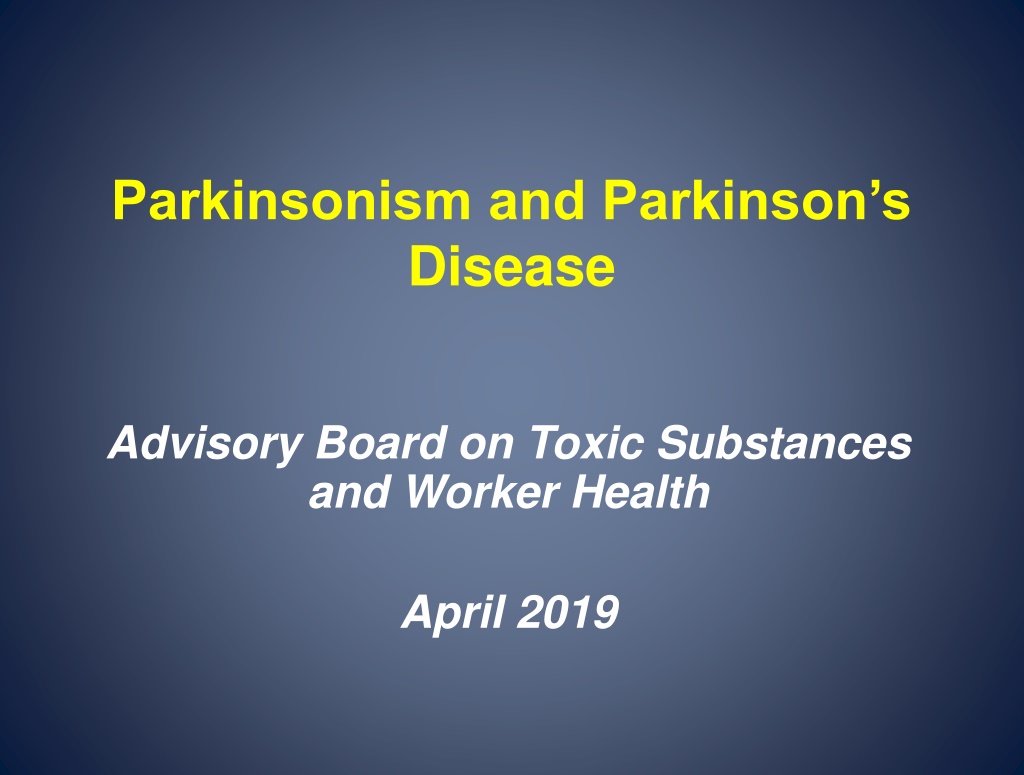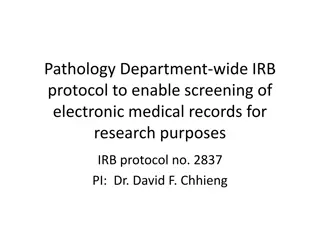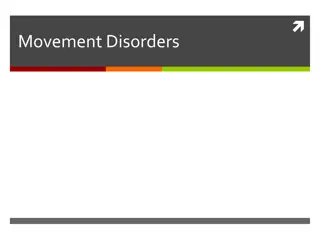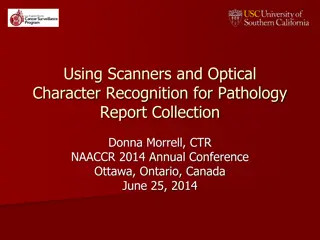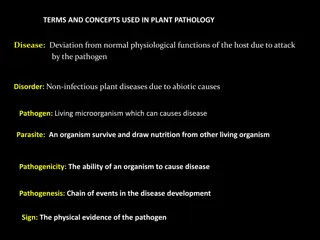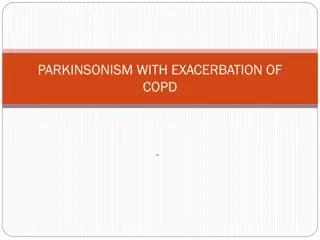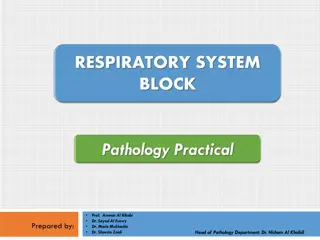Understanding Parkinsonism: Symptoms, Classification, and Pathology
Parkinsonism encompasses a group of progressive syndromes with symptoms such as bradykinesia, tremors, and rigidity. Parkinson's Disease is the most common form, but there are various classifications including primary and secondary causes. Pathologically, it involves the loss of dopaminergic neurons in the substantia nigra. This comprehensive guide explores the diagnostic criteria, treatment updates, and neurodegenerative aspects associated with Parkinsonism.
Download Presentation

Please find below an Image/Link to download the presentation.
The content on the website is provided AS IS for your information and personal use only. It may not be sold, licensed, or shared on other websites without obtaining consent from the author. Download presentation by click this link. If you encounter any issues during the download, it is possible that the publisher has removed the file from their server.
E N D
Presentation Transcript
Parkinsonism and Parkinsons Disease Advisory Board on Toxic Substances and Worker Health April 2019
Parkinsonism Group of progressive clinical syndromes characterized by parkinsonian symptoms: Bradykinesia and slowness of movement, fatigue, reduction of repetitive movements, difficulty initiating movements Rigidity stiffness/tightness of the limbs/trunk, facial muscles and/or Tremor shaking movement, upper limbs (hands - pill-rolling) Postuma RB, Berg D, Stern M, et al. MDS Clinical Diagnostic Criteria for Parkinson s Disease. Mov Disord 2015;30: 1591-1600.
Parkinsonism - Classification Primary Parkinson s Disease (PD) 70-80% of Parkinsonism cases Idiopathic up to 95% of all PD cases with genetic between 5-10% of cases Secondary Vascular (Lower Body Parkinsonism) Drug Induced (neuroleptics (typical) ,antipsychotics (atypical) , metochlopramide, MPTP) Infectious (postencephalitis, syphilis Metabolic (parathyroid, postanoxic) Structural (brain tumor, hydrocephalus) Exposure agents (Carbon monoxide, Carbon disulfide, Manganese (Mn), methanol, pesticides Parkinson-Plus (Atypical Parkinsonisms) Multiple Systems Atrophy (MSA) Progressive Supranuclear Palsy (PSP) Corticobasal Degeneration (CBD) Lewy Body Dementia (LBD) Hereditary Disorders Wilson disease Huntington Disease Neurodegeneration with brain iron accumulation (NBIA) PARK1,2,6,7,8 Source: 1) Rizek P, Kumar N, Jog M. An update on the diagnosis and treatment of Parkinson disease. CMAJ 2016. DOI10.1503/cmaj.151179; ) Brooks D. Diagnosis and Management of Atypical Parkinsonian Syndromes. J Neurosurg Psychiatry. 2002;72 Suppl I (pp.10-16) 2)
Parkinsonism - Pathology - Pathology (neurodegenerative): Loss of dopaminergic neurons in the substantia nigra -part of the midbrain - that controls reward seeking, muscle movement (fine movement), learning and addiction Dopamine neurotransmitter - chemical released by neurons - Molecular - abnormal accumulation, cell inclusions of normal proteins within neurons: - -synuclein (-o-pathies) - Parkinson s Dz, MSA - tau (-o-pathies) - PSP Source: 1) Dickson D. Parkinson s Disease and Parkinsonism: Neuropathology. Cold Spring Harb Perspect Med 2012;2:a009258 2) Rizek P, Kumar N, Jog M. An update on the diagnosis and treatment of Parkinson disease. CMAJ 2016. DOI10.1503/cmaj.151179 In: Farrer MJ. Genetics of Parkinson Disease. Paradigm Shifts and Future Prospects. Nat Rev Gernet 2006.:7(4):306-18 /
Parkinsonism and Parkinsons Disease ICD-9 vs. ICD-10 ICD 9 ICD 10* Parkinsonism Parkinson s Disease 332.0 332.0 G20 G20 Aliases: Paralysis Agitans, Idiopathic or Primary Parkinsonism or PD, Secondary Parkinsonism 332.1 G21 Drug Induced Neuroleptic Medication Induced Other Drug Induced 332.1 332.1 332.1 G21.1 G21.11 G21.19 Due to other external agents Carbon Monoxide Carbon Disulfide Manganese Vascular parkinsonism Other secondary parkinsonism Secondary parkinsonism, unsp. Parkinson-Plus 332.1 332.1 332.1 332.1 G21.2 T58.94XS 982.2 T56.894D 322.1 332.1 332.1 G21.4 G21.8 G21.9 332.0 G20 Multiple Systems Atrophy (MSA) Progressive Supranuclear Palsy (PSP) Corticobasal Degeneration (CBD) Lewy Body Dementia (LBD) 333.0 333.0 331.6 331.82 G13.8 G23.1 G31.85 G31.83 * ICD-10 - 10th Revision of the International Statistical Classification of Diseases and Related Health Problems in use since 1999, replaced ICD-9 as of October 1, 2015
UK Parkinsons Disease Society Brain Bank Clinical Diagnostic Criteria (UKPDSBRC), 1988 Designed for diagnosis in pathologic series, adapted by clinical community Did not identify early stages of disease, Diagnosis based on Parkinsonism criteria + Exclusion Criteria + Supportive Criteria 8 out of 10 patients with parkinsonism /PD diagnosed correctly (pooled diagnostic accuracy 82.7%, higher for experts in movement disorders Rizzo et al. Accuracy of clinical diagnosis of Parkinson Disease: A systematic Review and meta-analysis. Neurology 2016: 86(6):566-76
International Parkinson and Movement Disorder Society (MDS) Clinical/Research Diagnostic Criteria, 2017 Two step diagnostic process: - MDS Unified Parkinson s Disease Rating Scale (MDS-UPDRS) - 0 = normal to 4 = several, Maximum Score 199 with 2008 update to 272 - 65 items in four parts (to assess both motor and non-motor symptoms) - Part I, Mentation, Behavior and Mood - Part II Activities of Daily Living - Part III Motor Examination - Part IV Complications of Therapy Goetz C et al. Movement Disorder Society-Sponsored Revision of the Unified Parkinson s Disease Rating Scale (MDS-UPDRS): ScalePresentation and Clinimetric Testing Results. Mov Disord 2008;23:pp-2129-2170 Postuma RB, Berg D, Stern M, et al. MDS Clinical Diagnostic Criteria for Parkinson s Disease. Mov Disord 2015;30: 1591-1600.
International Parkinson and Movement Disorder Society (MDS) Clinical/Research Diagnostic Criteria, 2017 Supportive Criteria: 1) Clear, beneficial response to dopaminergic therapy; 2) Rest tremor of a limb; 3) Presence of olfactory loss or cardiac denervation on MIBG scintigraphy; 4) presence off levodopa induced sykinesias Red flags:: 1) Rapid progression of gait impairment; 2)A complete absence f of progression of motor symptoms >5 years; 3) severe dsyphnia and/or severe dysphagia ; 4) recurrent fails ; 5) absence of any non-motor symptoms despite >5 years of disease duration; 6) Bilateral symmetric parkinsonism Postuma RB, Berg D, Stern M, et al. MDS Clinical Diagnostic Criteria for Parkinson s Disease. Mov Disord 2015;30: 1591-1600.
Occupational Exposures and Risk of Parkinsonism/Parkinsons Disease - Research Polchorinated Biphenyls (PCBs) - Non-flammable, chemically stable, excellent electrical insulating properties - - wide industrial use, most commonly used: Aroclor 1242,1254 1260 - No longer manufactured, processed and distributed in the US (1977) but still found in the environment (Aroclor 1254 54% Cl 54% Cl half life 4.8 years) . On-going servicing of enclosed PCBs - Most common occupational exposure primarily through inhalation and/or skin - Dose Reconstruction Feasibility Study Oak Ridge Reservation (ORR) Health Studies (TN Dept .of Health, Oak Ridge Health Agreement Steering Panel) - PCBs used extensively at the Y-12, K-25 and X-10 facilities: - In electrical equipment, - as cutting fluid in machining operations - for fabrication of metal weapon parts, - as component of paints, coatings, adhesives, inks and gaskets
Occupational Exposures and Risk of Parkinsonism/Parkinsons Disease - Research - PCB mediated reductions in dopamine levels in experimental models (Seegal et al. 1986; 1989; 1990; 1991; 1994; 2002; Lee and Opanashuk 2004; Richardson and Miller 2004 - Significantly higher concentrations of PCBs in brain tissue of eight cases with PD (M/F 5/3; 70-85) compared to seven controls (M/F 7/0 50-72 (Corrigan et al. 2000) - Increased mortality from PD as an underlying COD (SMR 2.95, 95%CI 1.08-6.42) for highly exposed female workers from three electrical capacitor producing plants retrospective mortality study with IH JEM to estimate exposure (Steenland et al. 2006) - Increase in concentrations of PCBs in brain tissue of female subjects with dx of PD compared to controls (M/F 33/10; M/F=6/7) (Hatcher-Martin JM (2012)
Occupational Exposures and Risk of Parkinsonism/Parkinsons Disease - Research Solvents - Industrial use as degreasing agents (cleaning parts, machining equipment) and paint thinners - Most prevalent occupational exposures through inhalation or skin - Commonly used solvents at DoE complex - Trichloroethylene (TCE) - Toluene - Acetone - Hexane - Carbon disulfide (rubber, asphalt, resins)
Occupational Exposures and Risk of Parkinsonism/Parkinsons Disease - Research Solvents - Majority of population based studies to-date with solvents exposures treated as a single entity (Seidler et al. 1996; Smargassi et al 1998; McDonnell et al. 2003; Tanner et al. 2009) - Case reports and reports of small clusters of PD following chronic TCE exposures (Guehl et al. 1999; Gash et al. 2008) - TCE exposure in animal models shown to result in loss of dopaminergic neurons and reduced levels of dopamine (Guehl et al 1999; Gash et al. 2008 ;Lin et al. 2010; Sauerbeck et al 2012) - Ever-exposure to TCE associated with significantly increased risk of Parkinson s disease (OR =6.1, 95%CI 1.2 -33) in Twin Study (99 pairs) with lifetime solvent exposure assessment performed by IH (Goldman et al. 2012)
Occupational/Environmental Exposures and Risk of Parkinsons Disease - Research Metals - Wide industrial use with most prevalent inhalational exposures at DoE complex predominantly through metal fumes or metal dust during welding or machining operations - Iron and Copper exposures linked to reduction in dopamine levels in animal models (Oder et al. 1993; Barthel et al. 2003; Kaur et al. 2007; Yu et al. 2008) - Increased risk of PD following 20+ years of occupational exposures to copper (OR=2.49 , 95%CI 1.06-5.89), iron-copper (OR=3.89, 95%CI 1.40, 9.71) case-control (144/464), IH assessment of job history and exposure potential (Gorell et al. 1997, 1999a;1999b; Rybicki et al. 1999)
Occupational/Environmental Exposures and Risk of Parkinsons Disease - Research Pesticides - Wide agricultural use/farming applications with potential for bystander oral, inhalational and skin routes of exposures at DoE complex due to farming operations on-sites - Insecticides (organochlorines, rotenone, organophosphates), herbicides (paraquat) and fungicides (Carbamate) linked to reduction of dopamine levels in cell lines and animal models (Sanchez-Ramos et al. 1998; Degli Esposti, 1998; Betarbet et al. 2000, Kitazawa et al. 2001; McCormack et al. 2002; Hatcher et al. 2008; Cannon and Greenamyre, 2010) - Significantly higher concentrations of organochlorines in brain tissue of eight cases with PD (M/F 5/3; 70-85) compared to seven controls (M/F 7/0 50- 72 (Corrigan et al. 2000) - Increased risk of PD for insecticides (RR = 1.5, 95%CI 1.07, 2,11) and herbicides (RR = 1.4, 95%CI 1.08, 1.81) in pooled analysis for ever vs. never exposure (van der Mark et al. 2012)
International Parkinson and Movement Disorder Society (MDS) Clinical/Research Diagnostic Criteria, 2017 Clinicopathologic definition of PD (neuronal loss of substantia nigra with deposition of -synuclein remained but genetic mutations present with no -synuclein deposition (PSP) tauopathies? Defined early stages of disease: Pre-clinical - neurodegeneration has started but no symptoms (biomarkers not yet available) Prodromal - presence of neurodegenerative motor symptoms but not at a clinical threshold level - a category created for clinical trials and prospective cohort studies Clinical disease - presence of neurodegenerative motor signs - parkinsonism symptoms Clinically Established PD diagnosis Clinically Probable PD Diagnosis Postuma RB, Berg D, Stern M, et al. MDS Clinical Diagnostic Criteria for Parkinson s Disease. Mov Disord 2015;30: 1591-1600.
MDS Diagnostic Criteria, 2017 Postuma RB, Berg D, Stern M, et al. MDS Clinical Diagnostic Criteria for Parkinson s Disease. Mov Disord 2015;30: 1591-1600.
MDS Diagnostic Criteria, 2017 Postuma RB, Berg D, Stern M, et al. MDS Clinical Diagnostic Criteria for Parkinson s Disease. Mov Disord 2015;30: 1591-1600.
MDS Diagnostic Criteria, 2017 Postuma RB, Berg D, Stern M, et al. MDS Clinical Diagnostic Criteria for Parkinson s Disease. Mov Disord 2015;30: 1591-1600.
MDS Diagnostic Criteria, 2017 Postuma RB, Berg D, Stern M, et al. MDS Clinical Diagnostic Criteria for Parkinson s Disease. Mov Disord 2015;30: 1591-1600.
MDS Diagnostic Criteria, 2017 Postuma RB, Berg D, Stern M, et al. MDS Clinical Diagnostic Criteria for Parkinson s Disease. Mov Disord 2015;30: 1591-1600.
